People who know I have a Ph.D. in math often think that mathematics must help me in chess. But I have to tell them: not really. Having a mathematical mind is somewhat useful: in both subjects, it’s good to be able to hold in your mind long strings of “if this, then that.” But it is only on very rare occasions that chess actually resembles a math problem. And there are other factors that enter into almost every position, factors like psychology, fatigue, and time.
In today’s round four of the World Cup, there was a game that illustrates both sides of the argument very well — a position that was in some ways very mathematical, but then unfolded in a very different way from what the math would predict. Levon Aronian, #4 in the world, was White, and Daniil Dubov, #81, was Black.
FEN: 8/8/6k1/4K1p1/8/8/3R2P1/1b6 w – – 0 72
Here the computer and the online kibitzers were going crazy, saying that 72. g4! was an obvious win for White. Certainly it’s an elegant move — in fact, it’s almost a zugwang. Black can’t move his bishop or pawn, so he has to retreat with the king. After 72. … Kg7, though, how does White make progress? It seems as if all the roads to entry with his king are still barred.
The very cute answer is to chase the Black king back into the zugzwang position! White plays 73. Rd7+ Kg6 (the king has to go here; if he lets the White king into f6, it’s immediate death) 74. Rd1! Now observe how White keeps harassing the bishop until it runs out of squares: 74. … Bc2 75. Rd2 Bb1 (the bishop must stay on the b1-h7 diagonal at all times; otherwise Rd6+ followed by Kf5 will win the game for White) 76. Rb2! Bd3 77. Kd4! (diagram)
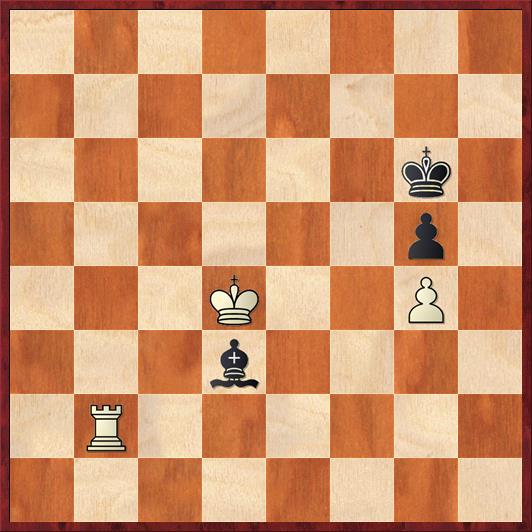 Position after 77. Kd4 (analysis). Black to move.
Position after 77. Kd4 (analysis). Black to move.
FEN: 8/8/6k1/6p1/3K2P1/3b4/1R6/8 b – – 0 77
At last the point of White’s combination becomes clear. Black’s bishop has run out of squares on the key diagonal b1-h7 and he must play 77. … Bf1. Now White plays 78. Rb6+ Kf7 79. Ke4! and the king marches to f5 next move.
This combination is truly mathematical. Black’s moves are completely forced, aside from trivial details like whether to move his king to f7 or g7. The mathematical principle involved is that there are 7 squares on the b1-h7 diagonal, so White somehow has to take each one of them away from the Black bishop. The rook takes away 2, the king takes away 2, the pawn takes away 1, and finally the Black king (a traitor to his own cause!) takes away the last two squares from the bishop. 2 + 2 + 1 + 2 = 7, therefore there are no squares left. Mathematics.
The combination is also “mathematical” in the way that each piece plays a precise role. Even the Black pawn on g5 is important; the need to defend that pawn is why Black’s king keeps getting sucked back to g6.
But instead of 72. g4, Aronian played 72. Ke6, and a groan went up among all the online kibitzers. How could he miss such an elementary winning move? They asked. Isn’t he supposed to be an endgame specialist? Hasn’t he studied his endings?
The groans kept getting louder and louder as Aronian, in fact, waited 18 more moves before playing the key move g4! Dubov also missed a couple chances to draw, as we’ll see. The computers obligingly pointed out the errors, and the spectators reacted: How could two top GM’s bungle this “kindergarten” endgame?
Okay, first of all, there’s no way it’s “kindergarten.” I could not figure this endgame out without consulting a computer or a tablebase, and I’m sure that none of the spectators could either. Once you have looked at the computer, in my opinion, you forfeit your right to say anything negative about the human players.
But more importantly for your chess education, I want to explain why both Aronian and Dubov played as a human chess grandmaster should. The reason is that chess is not math.
Yes, the variation I have highlighted in red is mathematically precise, and wins for White. But unless you are absolutely confident in your analysis, 72. g4 is the type of move that White should avoid. By playing this move, you have committed yourself. If things go wrong, your rook is going to be tied down to defending the g-pawn. You have also started the 50-move clock; there are going to be no more pawn moves, so you have to win in 50 moves or less.
Even more than this, 72. g4 violates the endgame principles that were developed by the Soviet school of chess. When you are in a winning endgame like this, the Soviets said, you should take your time. There is no rush. Let the difficulty of the position weigh on your opponent’s mind. Let him make more mistakes, which will make the win easier for you. Explore all the ways to improve your position before you make a definite commitment.
So Aronian played 72. Ke6. He isn’t going to commit his pawn yet. He is going to let his opponent twist in the wind. Moreover, another thing that the online peanut gallery didn’t know is that Aronian has a plan. He is planning to march his king to the eighth rank. Funny things happen when you start attacking your opponent from behind. And if the plan doesn’t work, he can always bring his king back and try plan B. It’s better to have a plan A, plan B, plan C, etc., then to stake everything on plan A. Unless you’re absolutely sure that plan A works.
If you play 72. g4, you are staking everything on math. By playing 72. Ke6, you allow psychology, fatigue, and time also to enter into the equation.
The next interesting moment happened after 72. Ke6 Be4 73. g3 (note that Aronian prefers this to g4, because it resets the 50-move rule without locking up the pawns) Bb1 74. Rb2 Bd3 75. Ke7 … (diagram)
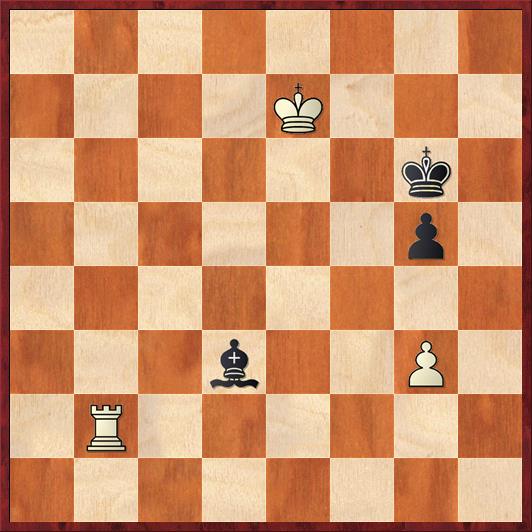 Position after 75. Ke7. Black to move.
Position after 75. Ke7. Black to move.
FEN: 8/4K3/6k1/6p1/8/3b2P1/1R6/8 b – – 0 75
Here was the first place where Dubov missed a draw. It’s pretty amazing, and I would never have found it without a computer. Because the computer sees g4 as a necessary move, the computer also says that Black should seize the opportunity given to him by White’s failure to play that move. Black should play 75. … Kf5! If White tries to keep the king out with 76. Rb4, Black cuts the rook off with 76. … Be4! Now there are two really remarkable drawing lines. First, if White plays 77. g4+, Black sacrifices his bishop with 77. … Kxg4! 78. Rxe4+ Kf3. White’s king is too far away to do anything about the passed g-pawn, and White will eventually have to give up his rook to stop it. This is a very thematic draw, and I think that Dubov could and should have seen it.
However, the other drawing line is something very few humans would see. Aronian could just continue his king march with 77. Kf7! After 77. … Bf3 78. Kg7 Bf3 79. Kh6 Be4 80. Rb5+ Kg4 it looks as if Black is toast, because the g-pawn falls with check: 81. Rxg5+ Kh3 (diagram)
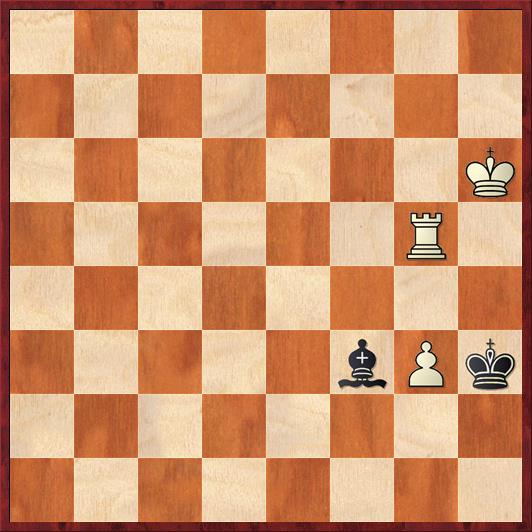 Position after 81. … Kh3 (analysis). White to move.
Position after 81. … Kh3 (analysis). White to move.
FEN: 8/8/7K/6R1/8/5bPk/8/8 w – – 0 82
But now a miracle happens! It turns out that, even though White is up a rook and pawn for the bishop, there is nothing he can do to prevent 82. … Bg4 and 83. … Kxg3. The game is a draw.
For anyone who thinks Dubov missed a “kindergarten” draw by not playing 75. … Ke5, think again. This is an amazing and exceptional line; it would take incredible self-confidence for Black to realize that he can give up the g-pawn and still draw. Just like Aronian, Dubov trusts general principles than unique, one-of-a-kind moves. He thinks that as long as he keeps his king on g6/g7, Aronian will never be able to make progress.
Another criticism of Dubov among the peanut gallery was that he played too quickly in this last phase of the game. One kibitzer said his play was “unprofessional.” At move 72, he and Aronian were about even on time, with 25 minutes on their clocks. By the end of the game, Dubov was up to 27 minutes, while Aronian was under 2.
Why didn’t Dubov take his time and look for miraculous defenses like this one? The reason is that Dubov understands the Soviet school of chess! He knows that Aronian’s objective is to wear him down and get him low on time — and he refuses to let that happen. He also knows that Aronian has more difficult decisions to make than he does, and he wants to give him less time to make him. Looking at what actually happened on the clocks, I would say that Dubov’s strategy of playing rapidly came close to working.
Okay, I’m going to fast-forward now to the end of the game.
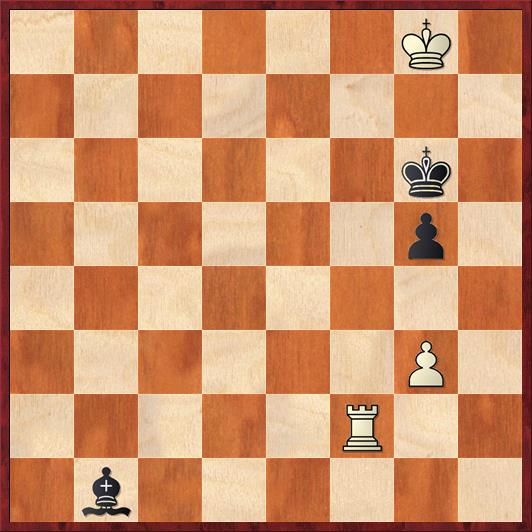 Position after 89. … Kg6. White to move.
Position after 89. … Kg6. White to move.
FEN: 6K1/8/6k1/6p1/8/6P1/5R2/1b6 w – – 0 90
We can see now that White’s plan has reached fruition. His king has gotten to g8, and this adds many new wrinkles to the position. Black has to watch out for the possibility that the White king will go to h7 and h6. But if Black keeps his king at g6 in order to bar the door, suddenly some unpleasant checkmate possibilities arise. This is what I meant when I said that “funny things would happen.”
I remember playing an endgame like this (as Black) once against Michael Aigner. I don’t have the game score any more, but I was an exchange down and thought that I had a good “fortress” setup. Nevertheless, I remember Michael playing a similar king march and breaking down my defenses. If he remembers the game and is reading this, I’d love to see it again!
Anyway, here Aronian finally played 90. g4! Why did he play it now, instead of 18 moves ago? Because he has now improved his position to the max. Black is not in a position to attack g4, because of the mate threats: after 90. … Be4 91. Rd2 (which actually happened) the move Bf3?? would be met by 92. Rd6 mate! Instead Dubov played 91. … Kf6, getting out of the mating net, and now a funny and ultimately meaningless thing happened. Aronian played 92. Rb2?, which gave Dubov his last chance for a draw. It turns out, according to the computer, that he should have played first 92. Re2! Bd3 93. Rb2, leading to the position in the game but with the subtle difference that the bishop is on d3 rather than e4.
If Dubov had been alert, he could once again have taken the opportunity to defend actively, rather than passively: 92. … Ke5! 93. Kg7 Kf4 94. Rb4 (diagram)
 Position after 94. Rb4 (analysis). Black to move.
Position after 94. Rb4 (analysis). Black to move.
FEN: 8/6K1/8/6p1/1R2bkP1/8/8/8 b – – 0 94
In this key position, everything depends on whose move it is. If it is Black’s move, as in the variation just given, Black draws with 94. … Kxg4. Once again we see this thematic idea of giving up the bishop in order to get a passed g-pawn that White can only stop by giving up his rook.
However, if we get to this position with White to move, then he wins by sacrificing the exchange. And that is exactly what happened in the game. Dubov played 92. … Bd3? 93. Rb6+ Ke5 94. Kg7 Kf4 95. Rb4+ Be4, and we reach the diagrammed position with White to move. Aronian correctly played 96. Rxe4+! Kxe4 97. Kg6 and Black resigned. If 97. … Kf4 98. Kh5, we reach the famous trebuchet position, a mutual zugzwang where whichever player is on move loses. Here, Black is on move.
Lessons:
- In a superior endgame, the Soviet school of chess says to torture your opponent. Take your time, keep them guessing, keep them from getting counterplay, and go for a tactical solution only when you’re absolutely sure that the tactics work out.
- In most inferior endgames, you are better off trying to defend actively than relying on a totally passive, fortress-style defense. Rule of thumb: If you’re not sure it’s a fortress, it’s not a fortress.
- Grandmasters prefer to think in terms of schemes rather than tactics in the endgame. We saw both players doing this; unfortunately for Dubov, he should have been a little bit more alert to the tactics.
- Zugzwang is a powerful but subtle tool! A true master knows how to use this weapon in the endgame.
- Against a computer opponent, Aronian would probably have only drawn this endgame. But that is a completely moot point. His opponent was human, and his play was exemplary against a human opponent.
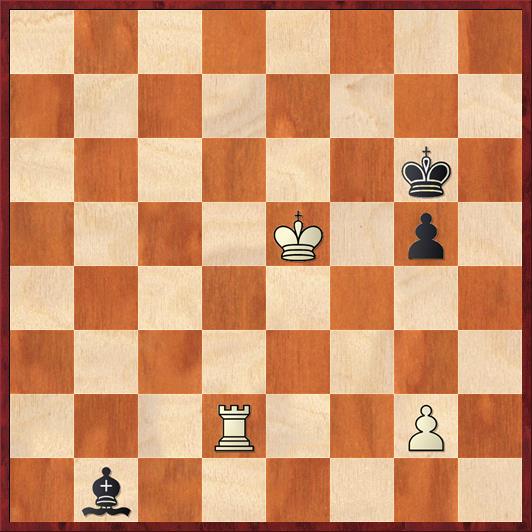



{ 12 comments… read them below or add one }
” Once you have looked at the computer, in my opinion, you forfeit your right to say anything negative about the human players.”
Brilliant
You have an excellent memory. This game was played way back in 2000. I was still an expert at the time, although just for one more week. I played in a small Chicago event the following week and scalped my first IM (Osmand Palos) and broke 2200 at the same time. You might notice that MSA rated these two tournaments out of order.
You were 100% correct in how you described the endgame.
[Event “LERA Jim Hurt Memorial”]
[Site “Sunnyvale”]
[Date “2000.09.02”]
[Round “2”]
[White “Aigner, Michael”]
[Black “Mackenzie, Dana”]
[Result “1-0”]
[WhiteElo “2167”]
[BlackElo “2136”]
1. e4 e5 2. Nf3 Nc6 3. Bb5 Nd4 4. Nxd4 exd4 5. O-O g6 6. d3 Bg7 7. f4 c6 8. Bc4
d5 9. exd5 cxd5 10. Bb5+ Kf8 11. Ba4 h5 12. Bd2 Bf6 13. Qf3 Bg4 14. Qf2 h4 15.
h3 Be6 16. Bb3 Kg7 17. Bc1 Ne7 18. Nd2 Nf5 19. Nf3 Qb6 20. Re1 Rac8 21. Rb1 Rc7
22. Ne5 Rhc8 23. Qf3 Qb4 24. Rd1 Qd6 25. Bd2 b6 26. a3 a5 27. Ng4 Qd7 28. Nxf6
Kxf6 29. a4 Kg7 30. Re1 Rxc2 31. Bxc2 Rxc2 32. Qd1 Rxd2 33. Qxd2 Ne3 34. b3 Qc7
35. Rxe3 dxe3 36. Qxe3 Qc2 37. Qd4+ Kg8 38. Rb2 Qc1+ 39. Kh2 Qe1 40. Qf2 Qc3
41. Qd2 d4 42. Qxc3 dxc3 43. Rc2 Bxb3 44. Rxc3 Bxa4 45. Rc8+ Kg7 46. Rb8 b5 47.
Ra8 Bc2 48. Rxa5 Bxd3 49. Ra6 Bc4 50. Rb6 Bd3 51. Kg1 Kf8 52. Kf2 Kg7 53. Ke3
Bf1 54. Kf3 Bc4 55. Kg4 Bf1 56. Kxh4 Bxg2 57. Rxb5 Kf6 58. Kg3 Be4 59. h4 Bf5
60. Kf3 Be6 61. Ke3 Bf5 62. Rb6+ Kg7 63. Rb7 Kf6 64. Kd4 Bh3 65. Rb5 Bg2 66.
Re5 Bh3 67. Kc5 Bf5 68. Kd6 Bg4 69. Kc7 Bd1 70. Ra5 Bb3 71. Kd8 Bc2 72. Ke8 Bd3
73. Rc5 Be4 74. Kf8 Bf5 75. Rxf5+ 1-0
I just realized that this game has four exchange sacrifices — the maximum possible! (At least, barring underpromotions to a rook.) In all likelihood, we own a world record that will never be broken for Most Exchange Sacrifices Accepted (one game, both players).
As for Most Exchange Sacrifices Offered, I once did a ChessLecture on a game by Kamsky that had something like seven or nine of them. But almost all of them were “passive” exchange sacs, offered but not accepted.
I doubt that Aigner-Mackenzie is a win until you blundered with Bf5. Using your mathematical analysis, the bishop had 5 squares on the b1 to f5 diagonal, and my rook could only control 2 of them.
Thanks! Looking at this game after watching Aronian-Dubov is definitely a bit like going back to kindergarten. Can’t believe I just gave the exchange away like that. I think it was time-pressure panic: I’ve got 5 seconds to move, oh what the hell, I’ll try this and see what happens. I still hadn’t learned that time pressure is exactly when you DON’T want to make major decisions that could cost you the game.
But anyway, we were talking about the endgame. It looks drawn but not dead drawn after you got your king to f8. For example, 74. …Bb1 75. Rc6+ Kf5 76. Kxf7 Kxf4 77. Rxg6 and wins. I think I have to keep the bishop on the long diagonal, so something like 74. … Bf3 75. Rb5 Bg4 76. Rb6+ Be6 looks as if it holds. For example, 77. Ra6 (almost zugzwang) Kf5 78. Kg7 Kxf4 79. Rxe6 fe 80. Kxg6 e5 and we both queen, with a draw.
I still like your idea of bringing the king to f8. Even if it doesn’t win, it turns the heat on the burner up a little bit, same as it did in the Aronian game.
The early parts of our game in 2000 were interesting too. Back then, I frequently played the Bird, and I’m not talking about the line of the Ruy Lopez! I was learning how to play 1.e4, but still had little tournament experience with it. You can be certain that this game was my first exposure to your pet Bird’s Defense. And Black got a comfortable middlegame.
The Rxc2 sacrifice was the right idea, but at the wrong time. Stockfish gives black a small advantage after the thematic 24… Rxc2. The point is that white has difficulty untangling without losing the b2 pawn.
Back then, the time control at most local tournaments was 30/90. Indeed it is likely that you had mere seconds to play your move 30… Rxc2. I always noticed that you play more creatively–but not always soundly–when low on time. I have never played you in blitz, but I would expect your games to be exciting!
I’m not so convinced. Yasser Seirawan and Aman Hambleton were doing an engine-less livestream and they saw basically all of the relevant ideas. They were calling out when it was flipping from a win to a draw. Of course, it’s sometimes easier to keep the right perspective on a position when you’re not the one playing the game.
Still, Aronian’s technique is usually superb. I’m willing to chalk this one up to fatigue.
Yasser’s endgame technique may include knowing/understanding this ending backwards and forwards. He was one of the outstanding endgame players in the world in his prime.
It is just after 5 in the morning so I may be too sleepy but in your 4th diagram, FEN: 8/8/7K/6R1/8/5bPk/8/8 w – – 0 82, you say that Black can draw with Bg4 and Kxg3, but in between those two doesn’t White play g2 and win?
Yes, you’re too sleepy! White is going up the board, and cannot move his pawn from g3 back go g2.
Don’t feel bad. This kind of confusion happens all the time when I give lessons to kids.
Excellent post! Here are my comments.
1. I agree with Paul B – you can’t use the silicon beast to diss fellow carbon-based life forms!
2. Endgames are often derided as dry and boring, but once you break down the thought behind good ones (as you did here) they are anything but!
3. Also, endgames benefit from their being, well, the end of the game. It’s the final scene, and the knowledge that the end is near should make them inherently more exciting. After all, even after a nice middlegame combination, there may still be time afterwards to recover and fight back. But the final blow in an endgame settles matters once and for all.
4. Your point about Aronian playing properly from a human perspective recalls your previous column re: precision. Many of Aronian’s moves weren’t objectively the most precise, but they were very human and presumably played according to the “make ’em suffer” plan.
5. I’d say that your example of counting the available squares to the BQB as an example of mathematics is more an example of arithmetic! I think it could be said that arithmetic happens a lot in chess, whether counting the number of attackers/defenders, or tabulating a material (im)balance. But as you say, chessplayers don’t think mathematically, with no apologies to Franklin K. Young.
6. On the other hand, one could say all of chess can be reduced to mathematics… but that’s another post.
7. And no doubt a mathematical or logical mind (what is the difference?) is very important to do well at chess.
8. As much as I’d like to mock Richard’s 5am pawn direction reversal, I have noticed that as I age I find I do have a harder time grasping which direction the pawns are moving when obvious patterns are removed. For example, in a position with the standard king-side pawn protection (f2, g2, h2 for White and f7, g7, h7 for Black), it’s obvious which way the pawns are moving. But once the Black pawn disappears in the above example, it’s easier to lose one’s bearings. I’ve found when analyzing games that in such cases it’s not always obvious to me which way pawns are going, and things can be downright confusing if viewing a game in progress from the side of the board. Luckily, this confusion hasn’t happened to me during a real game – at least, not yet. I’ve also occasionally in blitz mistaken a Black Bf8 for a castled rook. Try as I might, it doesn’t like to be moved from f8 to e8…
9. Finally, I can’t wait for your post on today’s Grischuk-MVL R v B ending!
Regards,
LS
“Here the computer and the online kibitzers were going crazy, saying that 72. g4! was an obvious win for White.”
This is exactly the kind of behaviour which hurts chess. It moved me to write about it: http://www.captainchess.com/abuse-of-engines-and-lack-of-respect-for-the-chess-master/
“Once you have looked at the computer, in my opinion, you forfeit your right to say anything negative about the human players.” Respect.